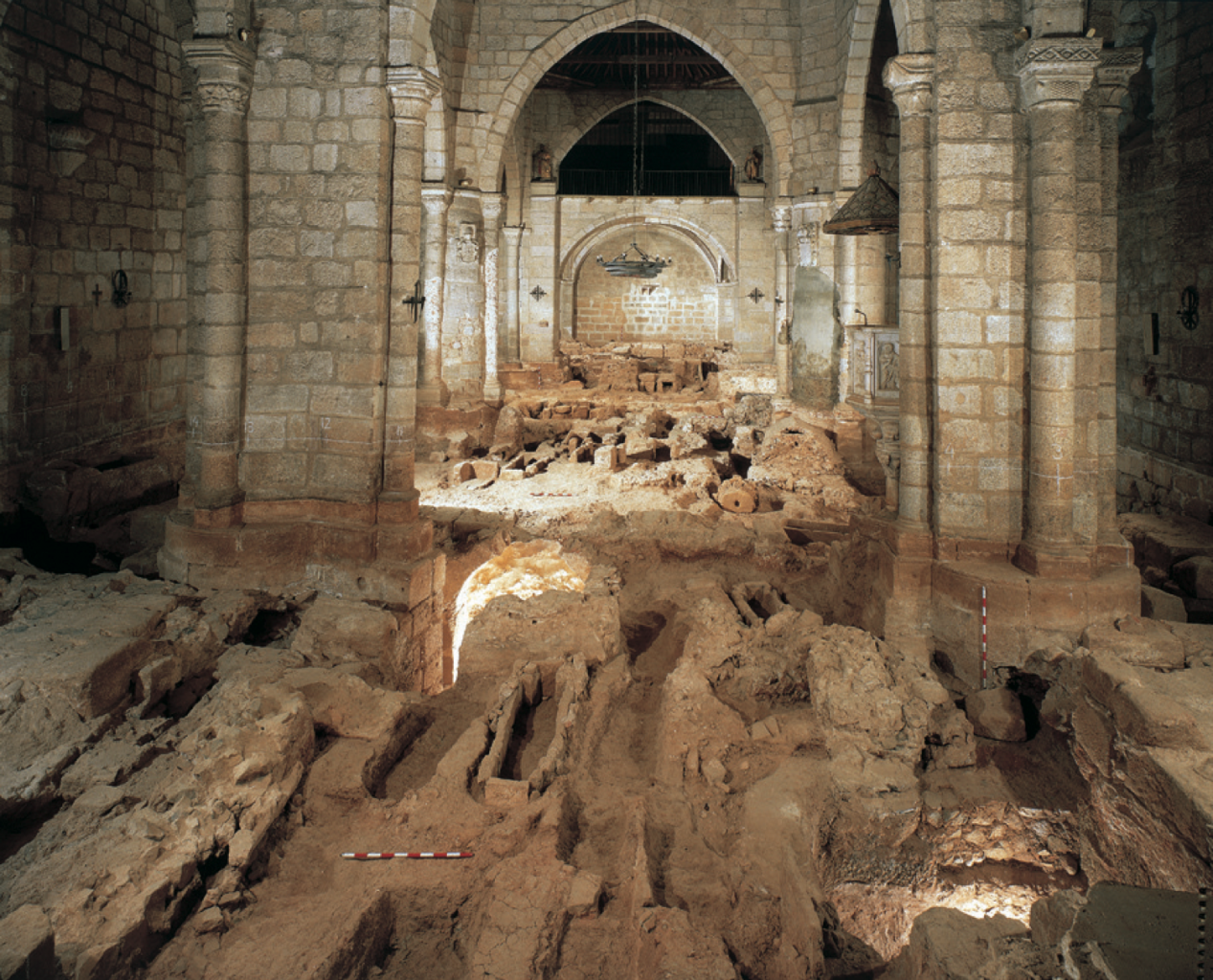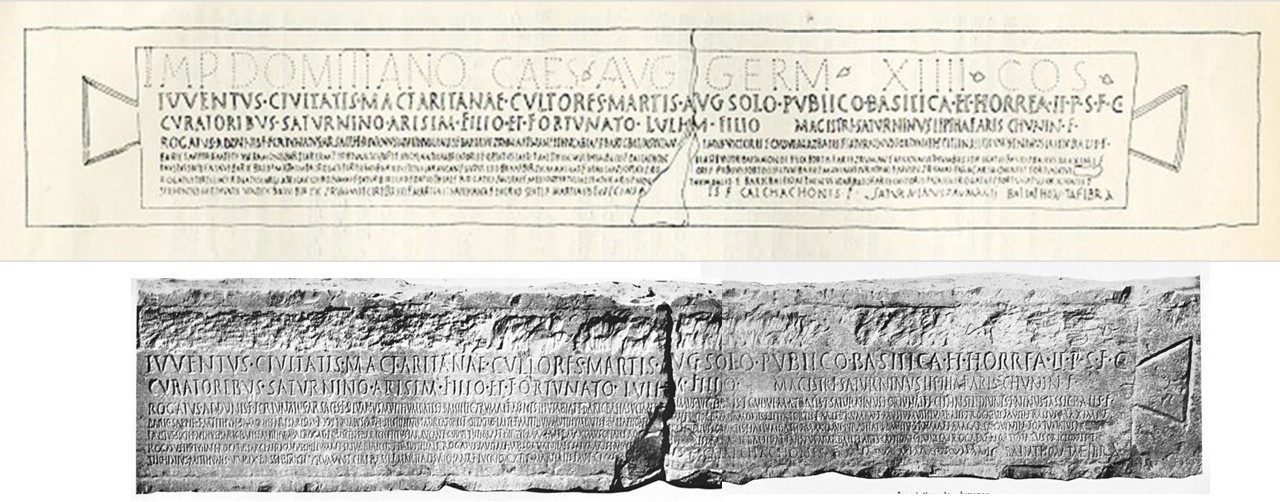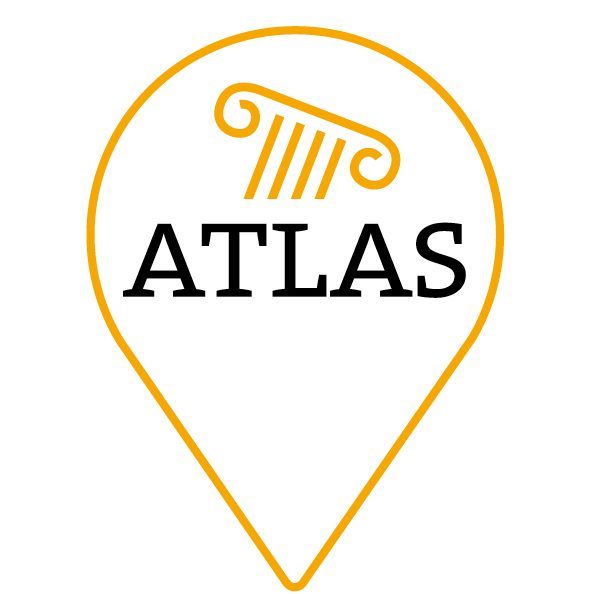As we have mentioned before, the project combines multiple sources, the most visible in our WebGIS are archaeology and epigraphy. Besides the differentiation in icons and on the panel these are divided among our two postdocs. Ada is responsible for the archaeological data and Pieter does the epigraphy. Despite the seemingly clear division between these sets, we do combine them to understand our data better. In this blog we will give you examples from our case studies where archaeology and epigraphy come together.
Baelo Claudia
That archaeology and epigraphy should not be two different parts in the project was made clear from the onset. Interestingly, the collaboration between Ada and Pieter started when they first met in La Rochelle, where we worked for the first time in the WebGIS and on our case study of Baelo Claudia. Entering one of the seven (!) inscriptions of Late Antique Baelo, Pieter noticed that one inscription on a terra sigillata plate (IRCB 135) was dated to the fifth century based on the ceramic type Hayes 87B. Ada said jokingly: “Let me check this!” and grabbed Hayes Late Roman Pottery. She found that the type Hayes 87 is dated to the fifth century, however, 87B is dated to the early sixth century. To our surprise our first collaboration already proved fruitful. Admittedly, we will not change the history of Baelo Claudia with this change. Nonetheless, it was a promising start and is a reminder to all epigraphers and ceramists to collaborate so we have our dates correctly.
Emerita Augusta
In our earlier blog on Mérida we already dedicated a few lines to the basilica of Santa Eulalia and its origins as a funerary basilica. Located in the northern suburban area of the city, this mid-fifth century basilica was built over a necropolis area dating back to the fourth century. The martyrial character of this basilica is corroborated by the maintenance of a mausoleum, which was enclosed within the central apse of the church and was accessible through the crypt, built at the same time as the building. This funerary monument played an important role in the development of the necropolis, as can be seen from the large number of tombs and epitaphs arranged around it, confirming that this was most probably the mausoleum that preserved the relics of the martyr from Mérida.

With the importance of Eulalia for the city of Mérida we expect to find some epigraphic evidence. Indeed two inscriptions have been found with reference to Eulalia. One of these refers to her house, CILAE 1407 / AEHTAM 612:
(crux) Hanc domum iu/ris tui, placata, posside, /martir Eulalia, · / ut cognoscens inimicus, / confusus abscedat, ·ut domus h(a)ec cum habi/tatoribus, te propitiante, florescant /Amen
Translated we get the following text:
Lie quietly, in thy own house, Martyr Eulalia, so that when he realises this circumstance, the enemy will flee in confusion, and so that, as is thy wish, this house and all who dwell within it shall flourish. Amen

The marble plaque was found as a reused piece in an excavation roughly 700 metres from the basilica at the Calle Forner. The reference to the house of Eulalia at first sight seems to refer to a church. However reading the text a bit closer we see that the inscription also mentions those that live in the house. This has led to a debate on whether the inscription refers to the basilica or another building, such as the xenodochium or possibly a monastery.
The second inscription, CILAE 1411, similarly refers to a religious building, and has similar problems. The inscription is found reused in the arch above the entrance of the Alcazaba.

(crux) dedicata est hac aula ad nome+[- – -] / riosissime matri Domini nostri H+[- – -] / dum carnem omniumque virginum princ[- – -] / ne cunctorum populorum catolice fide+[- – -] / iussa creare sunt reliquiae reco ndit+[- – -] / de cruce D(omi)ni n(ostr)i • s(an)c(t)i Iohanni Baptiste s(an)c(t)i S+[- – -] / s(an)c(t)i • Pauli • s(an)c(t)i • Iohanni Evangeliste s(an)c(t)i • Iacobi • s(an)c(t)i • Iuli[- – -] / s(an)c(t)e • Eulaliae • s(an)c(t)i • Tirsi s(an)c(t)i • Genesi • s(an)c(t)e Marcille • sub d(ie) VIII Kal(endas) Febru[- – -]
This church was dedicated in the name of the most glorious Mother of Our Lord Jesus Christ, in the flesh and Princess of all virgins and Queen of all the peoples of the Catholic faith, under whose sacred altar are kept relics of [—] on the cross of Our Lord, of Saint John the Baptist, Saint Stephen, Saint Paul, Saint John the Evangelist, Saint James, Saint Julian, Saint Eulalia, Saint Tirso, Saint Gines, Saint Marcilla, on the 8th day before the kalendas of February (25th January).
Again the church, referred to as aula, in this inscription is unlocated. It has been proposed that the church was found within the alcazaba, likely on the aljibe. Another possibility is the rededication of an existing church in Mérida. The cathedral of Mérida was formerly known as the Church of Jerusalem and later became the Santa Maria (VSPE IV ix 2). It could well be that this inscription commemorates the rededication of the cathedral.
Interestingly the epigraphy of the city of Mérida related to Santa Eulalia did not yield a dedication of the actual basilica of Santa Eulalia, but it gave us two more buildings where Santa Eulalia was revered.In the territory, in San Pedro de Mérida, we find a third inscription referring to Eulalia. The monogram on a tile is composed of the letters: L, S, N, A, E, C, T. These have been combined to read: Sancte Eulaliae.
Mactaris
The so-called ‘Schola des Juvenes’ is a famous example for the combination of archaeology and epigraphy. The name of the building comes from an interesting inscription reused on the stairs of the nearby thermal baths, known as the “Thermes du mégalithe”, probably built in the third century:

However, as this inscription dates to 88 CE and treats the building in the Imperial period, we will not go into this use. We will turn to the combination of archaeology and epigraphy for the later conversion to a Christian basilica as we tweeted before. The Christian basilica reused the western room and peristyle of the earlier building. Architecturally, it is a basilica with three naves, divided by a double colonnade placed directly over the previous mosaic pavement and made from recycled materials. The last two bays of the central nave were occupied by the choir, delimited by gates, and in the centre was an altar, for the base of which a funerary inscription was reused. At the foot of the basilica, another area has been identified that occupied the west wing of the peristyle of the previous building. The intercolumniation on this side of the former courtyard was walled off with recycled material, leaving a single access on the northwest side. This space has been interpreted as a narthex or counter-abdess, since a funerary monument reused as an altar base was found inside it, inserted within a rectangular ciborium.
In addition to repurposement of the existing architecture, we also see that the third century geometric, black and white mosaic in the apsed room was repurposed. In the sixth century the mosaic was broken to insert three new mosaics with epigraphy. We can date the inscriptions to the Byzantine period, presumably the sixth century, by the reference to the indictione found in the inscriptions. The indiction refers to the fifteen year tax cycle mostly attested in the fifth and sixth century. Unfortunately, the indiction dating only gives the year within the cycle, thus we can not specify the exact year. As it is a practice not followed by the Vandals, the inscriptions date to the Byzantine period. The similarity between the inscriptions is used to argue that they are contemporaneous. Although we should not forget the possibility of imitation when adding a new inscription. The smallest mosaic to the right could well be a later addition imitating the other two.

The three texts help us understand the reuse of the building as a Christian basilica:
+ Animo mente corp/oreque Constantin/us oriundus Paulini m/atreque (H)onorata / rabiem inimicorum / tropeo fidei vincens / cum Chr(ist)o fidelis per s(a)e/cula regnaturus / bis tricenos quat(t)uor / annos menses VIII / vixit / hic ultimus claudit dies / despositus sub d(ie) XIII Kal(endas) / Mai(a)s ind(ictione) quarta decima
ICMactar II,1
+ Terra premes te/neros iniusto ponde/re Manes qua<n=M>ta te/cum bona de summi/s duces ad ima hic / Honorata tibi mem/bra ponit animamque / Tonanti <h=TI>os tibi ap/ices filia <v=B>aledictu/ra discedam bis qua/ternos functa anno/s debitum vit(a)e finem r/eddidit sub die depo/sita octa<v=B>u(m) Id(us) / April<e=I>s ind(ictione) XIIII
ICMactar II,2
+ In (h)oc [tumulo] / deposita [est] / Co(n)st[antia(?) vix]/it in pace [an(n)u(m)] / unu(m) men[ses – – -] / die(s) III N(o)n(as) [- – -] / in[d(ictione)
ICMactar II,3
The clear giveaway is the cross that starts all three inscriptions. In addition to this we find more Christian elements in the texts themselves.
The texts also support the idea of inhumation in the basilica. The best example is the ‘In (h)oc [tumulo] / deposita [est]’ (in this grave lies…) found in the smallest mosaic. The other two texts are less obvious, but still allude to the inhumation in the site:
ICMac II-1: Hic ultimus claudit dies / Here he is buried on his last day
ICMac II-2: Hic Honorata tibi membra ponit animamque Tonanti / Here Honorata lays down her body and soul, for you, thundering god
The thundering god might put us on the wrong foot, we might start thinking about Jupiter or other gods of thunder.
The evidence for inhumation in such a central position raises another question: Are these martyrs? Unfortunately, the inscriptions are not clear in this regard. We could interpret the largest inscription in such way it supports the idea of a martyr:
…rabiem inimicorum tropeo fidei vincens… / …victorious over the fury of the enemies with the trophy of the Faith…
We could interpret it as stating that even though Constantinus died due to the fury of his enemies in the form of persecutions, as a result of his continued faith he is now victoriously in heaven. However, it could also refer to the victory over temptations put forward by the devil.
But, in any case, again the joint work and the combination of epigraphic and archaeological data allow us to obtain a much more complete picture of this Christian basilica and its development on an earlier building. In fact, as you can see in the above examples, despite the distance between the ATLAS postdocs working in Madrid and Hamburg and their different specialisations, they are well-able to bring together the data. This combination of the fields is the core and one of the novelties of the ATLAS project, where we bring together the archaeology and epigraphy into one WebGIS. From this we are able to further our understanding of Late Antiquity.
